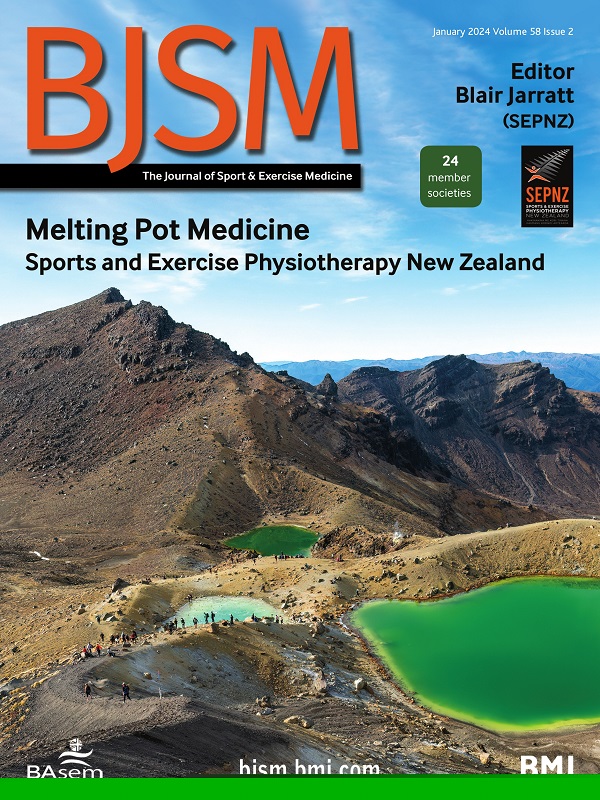能量缺失:朝着检测有意义的人类“骨骼肌”能量损失的方向发展
IF 16.2
1区 医学
Q1 SPORT SCIENCES
引用次数: 0
摘要
到2050年,全球人口预计将超过100亿,其中约17%的成年人超过65岁这些老龄化人口面临着与年龄相关的运动功能下降和多种健康疾病患病率上升的更高风险。研究和公共政策旨在检测和防止整个生命周期中运动功能状态的加速衰退,这对于解决这一问题至关重要。这篇社论介绍了“阳痿”的概念,并对其未来潜在的临床应用提出了见解。“力量不足”一词已被引入描述与衰老、疾病和/或缺乏运动相关的“骨骼肌”力量下降,并被提议作为健康衰老的新生物标志物与肌肉减少症和动力减少症的原始概念不同,动力减少症的中心是在运动任务中观察到的来自“骨骼肌”收缩的功率输出与最大力量和肌肉质量相比,力量随着年龄的增长下降得更快,并且与老年人摔倒、功能能力和生活质量增加的风险有更高的关联肌肉减少症全球领导力倡议最近提出的肌肉减少症的全球概念定义中排除了力量测试(但不是最大力量测试),这进一步支持了力量减少症概念的引入。此外,多种因素可以影响衰老速度(例如睡眠),这意味着相同实足年龄的两个人可能以不同的速度衰老。我们的观点是,与肌肉质量和力量相比,人类的运动能力是生物年龄的更好标志;…本文章由计算机程序翻译,如有差异,请以英文原文为准。
Powerpenia: moving towards the detection of meaningful human ‘skeletal muscle’ power loss
By 2050, the global human population is expected to have more than 10 billion people with~17% adults over 65 years old.1 This ageing population is at higher risk of age-associated declines in motor function and an increased prevalence of multiple health disorders.2 3 Research and public policies aimed at detecting and preventing the accelerated decline of motor functional status throughout the life cycle are essential to address this. This editorial introduces the concept of ‘powerpenia’ and presents insights for its potential clinical application in the future. The term ‘powerpenia’ has been introduced to describe a decline in ‘skeletal muscle’ power associated with ageing, disease and/or physical inactivity, and is proposed as a new biomarker of healthy ageing.4 Unlike the original concepts of sarcopenia and dynapenia, powerpenia centres on the power output observed during motor tasks derived from ‘skeletal muscle’ contractions.4 Compared with maximal strength and muscle mass, power is known to decline with age more rapidly, and to have higher association with an increased risk of falling, functional competence and quality of life in older adults.4 The introduction of the powerpenia concept is further supported by the recent exclusion of power testing (but not maximal strength testing) in the global conceptual definition of sarcopenia proposed by the Global Leadership Initiative in Sarcopenia .5 Moreover, multiple factors can influence the ageing rate (eg, sleep), which means that two human individuals of the same chronological age may be ageing at different rates. Our perspective is that human motor power is a better marker of biological age compared with muscle mass and strength; …
求助全文
通过发布文献求助,成功后即可免费获取论文全文。
去求助
来源期刊
CiteScore
27.10
自引率
4.90%
发文量
217
审稿时长
3-8 weeks
期刊介绍:
The British Journal of Sports Medicine (BJSM) is a dynamic platform that presents groundbreaking research, thought-provoking reviews, and meaningful discussions on sport and exercise medicine. Our focus encompasses various clinically-relevant aspects such as physiotherapy, physical therapy, and rehabilitation. With an aim to foster innovation, education, and knowledge translation, we strive to bridge the gap between research and practical implementation in the field. Our multi-media approach, including web, print, video, and audio resources, along with our active presence on social media, connects a global community of healthcare professionals dedicated to treating active individuals.

 求助内容:
求助内容: 应助结果提醒方式:
应助结果提醒方式:


